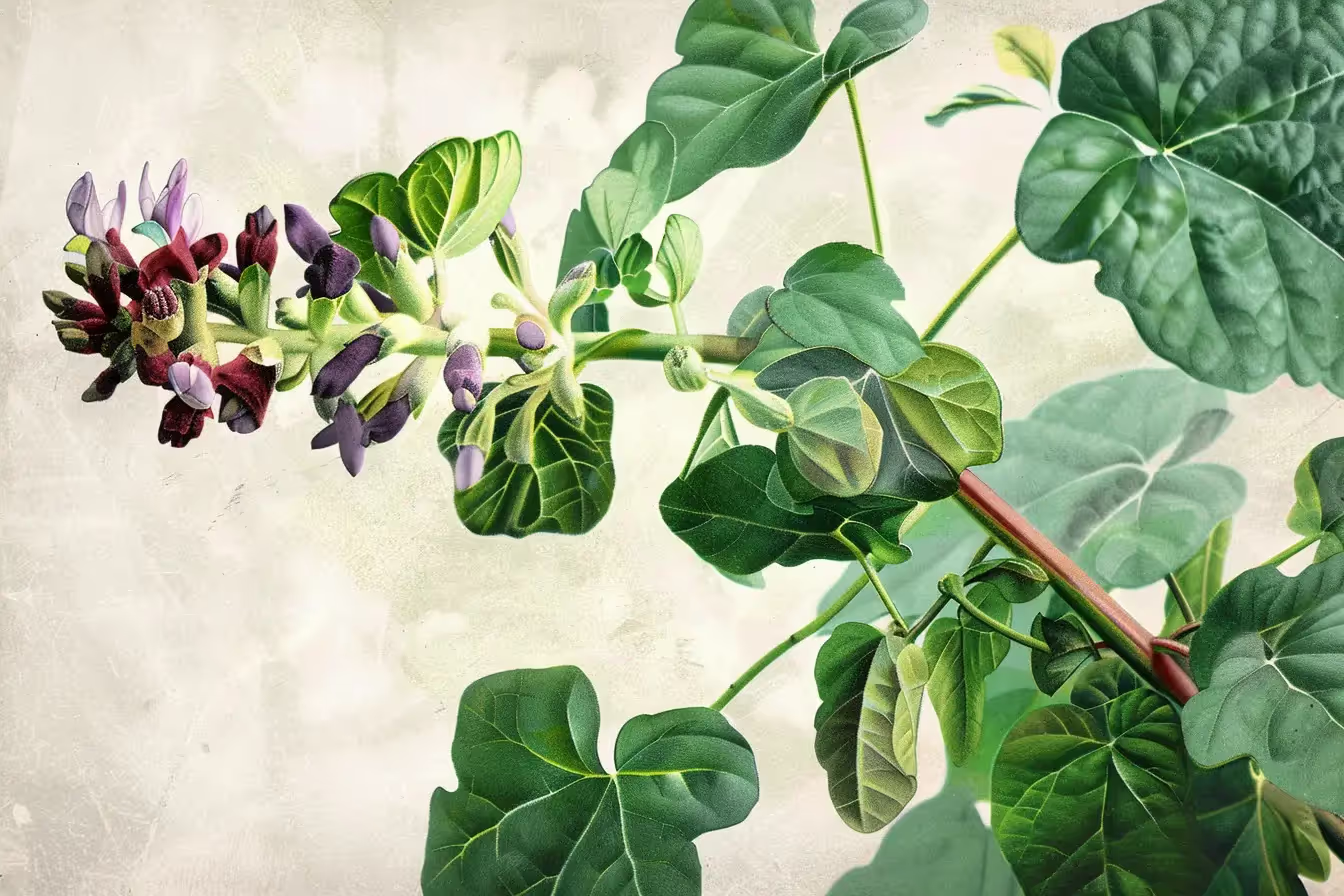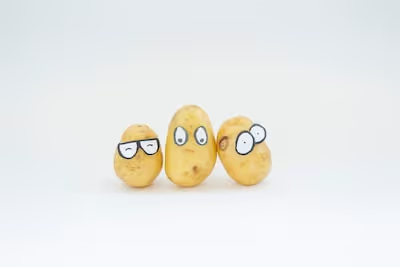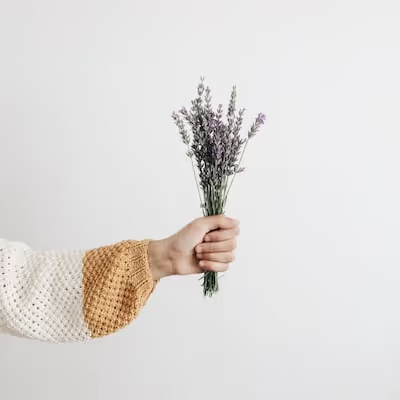Growing Kudzu: A Simple Gardener's Guide to Lush Vines

Growing Kudzu
Growing kudzu starts by planting hardy root crowns in sunny spots with well-draining soil. This vigorous vine thrives best when watered regularly during its first season, rapidly covering fences or trellises. Because kudzu can quickly take over, checking local planting guidelines before growing kudzu at home keeps your garden flourishing responsibly—read on to discover smart gardening practices for this controversial yet fascinating plant.
Cheatsheet: Thrive with Fast-Growing Kudzu Vines
🌱 Site & Soil Prep
- Full sun (6+ hrs), tolerate part shade.
- pH 6.0-7.2. Drainage essential.
- Loosen soil 8 in / 20 cm deep. Add compost.
🌞 Planting & Spacing
- Plant after frost. Soil 65°F+ / 18°C+.
- Seed or root cutting: bury 1 in / 2.5 cm deep.
- Space 4 ft / 1.2 m apart. Kudzu spreads fast—plan containment.
💧 Water & Feed
- Water 1 in / 2.5 cm weekly until established.
- Stable growers need less irrigation.
- Optional: light, all-purpose fertilizer during early growth.
⚠️ Contain & Prune
- Trim monthly to control spread.
- Trellises, fences, or wire frames direct vines upward.
- Never compost trimmings to avoid spread.
🌿 Harvest & Use
- Young shoots, leaves, & roots edible—protein, vitamins, isoflavones.
- Harvest leaves under 4 in / 10 cm long, before toughening.
- Roots can reach 300 lbs / 135+ kg; only dig when fully mature.
- Used in teas, salads, herbal remedies.
🧰 Tools & Products You’ll Need
- Sharp pruners
- Trowel & shovel
- Sturdy gloves
- Trellis or fencing
- Compost or balanced fertilizer
🔑 Step-by-Step
- Till & amend soil in early spring.
- Plant seeds or cuttings after last frost.
- Water thoroughly first 2–3 weeks.
- Install support before vines tangle.
- Trim monthly for control & shape.
- Harvest leaves or roots as desired.
🌍 Fast Facts
- Can grow 1 ft / 30 cm—in a single day in ideal conditions.
- Fixes nitrogen, enhances poor soils.
- Root powder: traditional thickener, home remedy.
- Plant in containers to limit runaway growth.
-
Growing Kudzu: A Simple Gardener’s Guide to Lush Vines
I learned to respect kudzu the first summer I tested it in a corrugated stock tank, and I still keep the pruning shears on a hook by the gate. It rewards attention with deep shade, then asks for more.
First, the legal and ethical reality check
Pueraria montana var. lobata is listed as invasive or noxious in many regions of North America, and planting may be restricted or banned. Check your state or provincial rules before you buy seed or cuttings, and confirm disposal rules for green waste.
“Kudzu can grow up to a foot a day in ideal summer conditions and smother trees, powerlines, and buildings.” Sources: USDA Forest Service and National Invasive Species Information Center.
I grow it only in contained trials or removals, never near woodlots or riparian edges. If you want a guilt free screen, see the alternatives section below.
Site selection for Growing Kudzu
Full sun fuels the machine, aim for 6 to 8 hours minimum. Shade slows it, though the roots patiently wait for your guard to drop.
Pick a spot downwind from native trees and shrubs, because runners will probe every weakness. Keep 30 feet, 9 meters, clear around the footprint if you are growing in open soil.
Containment that actually works
The only setups that have never burned me use physical barriers. Bury 30 to 60 mil HDPE root barrier 24 to 36 inches deep, 60 to 90 cm, with seams overlapped and taped.
Better yet, plant in a bottomed metal stock tank or a lined masonry bed with a 2 inch, 5 cm, inward lip. Patrol monthly, even in winter thaws.
Climate, timing, and expectations
Growing Kudzu is most vigorous in USDA Zones 7 to 10, serviceable in 6, dieback in 5 with roots surviving. Plant after soil hits 60 F, 16 C, and night temps settle above 55 F, 13 C.
It surges between 77 and 95 F, 25 to 35 C. A single crown can throw 50 to 100 feet, 15 to 30 m, of vine in one season with enough water and heat.
Soil and nutrition
Kudzu is a legume that fixes nitrogen via root nodules, so skip the high N fertilizer once established. Target a pH of 6.0 to 7.5, and add phosphorus and potassium if a soil test flags lows.
It tolerates clay and sand, yet thrives in a well drained loam with 3 to 5 percent organic matter. Mulch 2 to 3 inches, 5 to 8 cm, to keep crowns cool and suppress opportunists.
Propagation options
Seeds have a tough coat, scarify by nicking or a 12 to 24 hour warm water soak. Sow 0.5 inch deep, 1.2 cm, after frost, then thin to 6 to 10 foot spacing, 1.8 to 3 m, if you dare.
Cuttings from semi ripe vines root fast under high humidity, and crown divisions with a live bud take off like rockets. I prefer crown pieces, they establish with less sulking.
Trellising, training, and pruning
Plan for weight, wet vines get heavy. I use 4 by 4 cedar posts set 3 feet deep, 0.9 m, strung with 12 gauge galvanized wire and a diagonal brace.
Train early to a few leaders to avoid chaos. Cut back runners weekly to maintain a clean skirt, and clip every tendril that reaches the ground or a fence gap.
Water and establishment
First season, give 1 inch of water a week, 25 mm, split in two waterings if heat spikes. After that, it taps deep and handles moderate drought, though growth slows.
In containers, drench deeply, then let the top 2 inches, 5 cm, dry. Container vines need feeding with low N, higher P and K every 4 to 6 weeks in summer.
Real world growth, the good and the bad
On a south facing fence in Georgia clay, my test vines hit 8 to 12 inches of new growth per day in July, 20 to 30 cm. In a cool, foggy coastal site, they idled at 2 to 3 inches, 5 to 8 cm.
Shade arrives fast, which is the whole point for many growers. Overhead fruiting trees and neighbor’s hedges do not thank you.
Uses beyond shade
Tender shoots, leaves, and flowers are edible when cooked, mild and pea like. Roots yield a high grade starch known as kuzu in Japanese cuisine, though extraction is labor heavy.
Bees hit kudzu flowers for late summer nectar, and goats will clean a patch to the nub with a good fence. Some herbal traditions use kudzu isoflavones, always consult a professional before ingesting extracts.
Control and the escape plan
If Growing Kudzu goes sideways, act fast. Cut all vines at the base, bag cuttings, then smother crowns with a light proof tarp for at least a full season.
Repeat defoliation every 2 to 4 weeks starves roots over 2 to 3 years. Targeted grazing works, I have cleared quarter acre lots with goats in two seasons with tight rotation.
For chemical control, extension bulletins recommend systemic herbicides applied late summer into early fall for maximum root uptake. Expect multiple years of follow up, always follow the label and local rules.
“Eradication typically requires repeated treatments across several growing seasons.” Sources: University of Georgia Extension and USDA Forest Service management guides.
Pests, diseases, and safety
Kudzu bug, Megacopta cribraria, can appear on vines and adjacent legumes, and it stinks when crushed. Wear gloves, long sleeves, and check for ticks when working dense thickets.
Avoid harvesting near roadsides or rights of way due to possible herbicide drift. Sap can irritate some skin types, wash after handling.
My field notes, the honest part
The fastest screen I ever grew was kudzu on a cattle panel arch inside a buried barrier box, it covered 20 feet, 6 m, in seven weeks. The messiest call back I ever got was a client who let two runners hop the mulch line.
I now keep a bright flag on each leader and a calendar reminder every Friday in summer. The vine stays gorgeous, and my sleep stays easy.
Top alternatives to Growing Kudzu for fast, lush coverage
- American wisteria, Wisteria frutescens, native, tamer than Asian species, fragrant, Zone 5 to 9.
- Crossvine, Bignonia capreolata, evergreen in warm zones, trumpet flowers for hummingbirds, Zone 6 to 9.
- Trumpet honeysuckle, Lonicera sempervirens, non running, coral flowers, Zone 4 to 9.
- Hops, Humulus lupulus, dies back each winter, vigorous summer screen, cones for brewing, Zone 3 to 8.
- Hyacinth bean, Lablab purpureus, fast annual, purple pods and flowers, replant each spring.
- Akebia, Akebia quinata, semi evergreen, check local invasiveness before planting.
Commercial checklist for Growing Kudzu, or its substitutes
- Barrier: 30 to 60 mil HDPE root barrier, depth 24 to 36 inches, 60 to 90 cm, plus sealing tape.
- Structure: 4 by 4 posts, galvanized eye bolts, 12 gauge wire, turnbuckles, post mix, and gravel for drainage.
- Tools: bypass loppers, folding saw, heavy gloves, and a serrated sickle for quick nips.
- Mulch and soil test kit, plus P and K amendments if needed.
- For control or grazing plans: goat panels, portable electric netting, and a sprayer rated for herbicide if legal and desired.
FAQs that match real search intent
How fast does it grow. In heat and sun, figure 1 foot per day, 30 cm, with regular water.
Is Growing Kudzu legal. In many places it is restricted or banned, check your local agriculture department before planting or moving plant material.
Will it survive winter. Roots handle cold to roughly Zone 6 with vigor, tops die back with frost and resprout from crowns.
Can I grow it in a pot. Yes, use a 100 gallon, 380 L, stock tank or larger with a trellis, and still patrol for runners.
Does it need fertilizer. After establishment, nitrogen is rarely needed, focus on balanced minerals and mulch.
Credible references worth reading
- USDA Forest Service, Invasive Plants Field and Management Guides for Kudzu.
- National Invasive Species Information Center, Kudzu species profile and regulatory status.
- University of Georgia Extension, Kudzu biology and control recommendations.
- North Carolina State Extension, Kudzu bug identification and management.
Frequently Asked Questions About Growing Kudzu
What conditions does kudzu thrive under?
Kudzu thrives vigorously in warm, humid climates with abundant sunshine, where soil drains freely yet retains moisture. Offer it full sun to partial shade, and you'll witness this assertive vine colonize space rapidly.
How often should kudzu plants be watered?
Regular watering is imperative during the plant's early existence. Once established, kudzu develops resilient roots, withstanding dry spells effortlessly. Water deeply once weekly in prolonged drought; otherwise, rainfall usually suffices.
Does kudzu require fertilization?
Kudzu rarely asks for supplemental nutrients. Its inherent ability to fix nitrogen enriches the soil naturally. Still, a modest application of balanced fertilizer at planting can accelerate initial vigor.
How can kudzu growth be controlled effectively?
Containment demands rigorous pruning and vigilant monitoring. Regularly trim creeping vines and promptly remove stray shoots to curtail aggressive expansion. Physical barriers or containers may also restrict its exuberant tendencies.
Can kudzu be cultivated indoors?
Indoors, kudzu challenges even devoted gardeners. It craves ample sunlight and expansive space. If determined, position kudzu near south-facing windows, prune consistently, and consider a sizable container to accommodate sprawling roots.
Are pests or diseases problematic for kudzu?
Kudzu laughs in the face of most pests and diseases, proving remarkably resistant. Occasionally, fungal afflictions or insects may appear, yet they're seldom detrimental enough to threaten established vines. Maintain good air circulation and prune regularly to mitigate these rare occurrences.
Growing Kudzu is both simple and wild—just what the impatient gardener craves and the cautious one fears. With the right care, you get lush vines that can cover a fence or trellis in no time. But don’t underestimate its appetite for space. Regular pruning and a watchful eye will keep it in check. If you’re after fast coverage and don’t mind a bit of taming, kudzu’s your vine. Give it sun, well-drained soil, and respect. Like many vigorous climbers, it rewards boldness. Grow it right, and you’ll have a tangled patch of green that never apologizes for being alive.
Health Benefits of Kudzu: Nutritional and Medicinal Uses
Powerful Antioxidant Properties
Kudzu root contains isoflavones, active compounds shown in research to reduce oxidative stress and inflammation, contributing to improved heart health.
Natural Remedy for Alcohol Dependence
Clinical trials suggest kudzu extract decreases alcohol cravings, lowering overall alcohol consumption by approximately 30-40%.
Support for Diabetes Management
Kudzu root extract has demonstrated potential to stabilize blood sugar and enhance glucose metabolism, benefiting individuals managing diabetes or insulin sensitivity issues.
Promotes Digestive Harmony
Traditionally, kudzu starch soothes digestion, eases diarrhea symptoms, and relieves mild digestive discomfort when consumed as tea or broth.
Nutrient-Dense Forage Option
- High in protein (14-20%), comparable to alfalfa, providing livestock with nutritious feed.
- Rich in vitamins A and C, calcium, phosphorus, and iron, enhancing animal health and self-reliance.
Simple Preparations for Health Use
- Herbal Tea: Steep dried kudzu root flakes (2 tsp per 8 oz/240 ml water) for digestive support.
- Cooking Ingredient: Substitute kudzu starch for cornstarch as gluten-free thickener in soups and sauces.
Caution:
Pregnant, nursing women and individuals on medication should consult a healthcare provider before incorporating kudzu regularly.
Find out which plants will thrive in your garden!
Answer a few fun questions and get custom plant recommendations perfect for your space. Let’s grow something amazing together!

start your season





